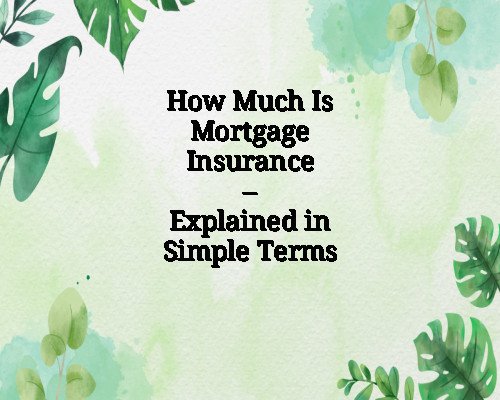How Much Is Mortgage Insurance – Explained in Simple Terms
Mortgage insurance protects lenders when borrowers can’t make payments, but how much it costs depends on loan type, down payment, and credit score.
What Is Mortgage Insurance?
Mortgage insurance is a financial safeguard for lenders when borrowers take out a home loan with a low down payment. If you can’t repay your mortgage, the insurance reimburses the lender for their loss. While it benefits the lender, it’s usually paid for by the borrower.
There are two primary types of mortgage insurance:
-
Private Mortgage Insurance (PMI): Common for conventional loans.
-
Mortgage Insurance Premium (MIP): Required for FHA loans.
Understanding how much mortgage insurance costs can help you plan your finances more effectively when buying a home.
Why Mortgage Insurance Is Required
Mortgage insurance is generally required when your down payment is less than 20% of the home’s value. It reduces the risk to the lender, allowing you to qualify for a loan even with a smaller upfront investment.
Lenders often categorize borrowers with less than 20% equity as higher risk. By requiring mortgage insurance, they mitigate potential losses while still offering accessible loans to buyers.
How Much Does Mortgage Insurance Cost?
Mortgage insurance costs vary based on:
-
Loan type
-
Loan amount
-
Down payment
-
Credit score
-
Loan term
Let’s break it down by insurance type.
Private Mortgage Insurance (PMI) – Conventional Loans
PMI is typically required when you put down less than 20% on a conventional loan. PMI can be structured in several ways:
-
Borrower-paid monthly premiums (most common)
-
Single upfront premium
-
Lender-paid PMI (cost built into interest rate)
Typical PMI Cost Range
PMI usually costs 0.22% to 2.25% of the original loan amount per year, depending on your credit profile and down payment.
Example:
Loan amount: $300,000
PMI rate: 0.5%
Annual cost: $1,500
Monthly cost: $125
PMI Cost Based on Credit Score
| Credit Score | Down Payment | PMI Rate (Approx.) |
|---|---|---|
| 760+ | 5% | 0.30% – 0.50% |
| 700–759 | 5% | 0.45% – 0.70% |
| 620–699 | 5% | 0.85% – 1.50% |
Better credit means a lower PMI rate. The rate also decreases as your down payment increases.
FHA Mortgage Insurance Premium (MIP)
For FHA loans, mortgage insurance includes:
-
Upfront Mortgage Insurance Premium (UFMIP): 1.75% of the loan amount (can be rolled into the loan).
-
Annual Mortgage Insurance Premium: 0.15% to 0.75%, paid monthly.
Example:
Loan amount: $300,000
UFMIP: $5,250 (1.75%)
Annual MIP: $1,350 (0.45%)
Monthly MIP: $112.50
FHA loans require MIP regardless of down payment. If your down payment is less than 10%, MIP remains for the life of the loan. If it’s 10% or more, it lasts 11 years.
VA and USDA Loans
-
VA Loans: No mortgage insurance, but a one-time funding fee is required.
-
USDA Loans: Include an upfront guarantee fee (1%) and an annual fee (0.35%).
Though not called “mortgage insurance,” these fees function similarly in protecting lenders.
How to Lower or Eliminate Mortgage Insurance
Paying mortgage insurance isn’t always permanent. Here are ways to reduce or eliminate it:
1. Put Down at Least 20%
If you’re buying a home, making a 20% down payment lets you avoid PMI entirely on conventional loans.
2. Refinance the Loan
If your home appreciates in value or you’ve paid down enough of your mortgage, you might be able to refinance into a new loan without PMI.
3. Request PMI Cancellation
Conventional PMI can be removed once your loan-to-value (LTV) ratio hits 78%, based on the original home value. You can also request cancellation at 80% LTV.
4. Improve Your Credit Score
Higher credit scores qualify for lower PMI rates. Taking steps to improve your score before applying for a mortgage can significantly lower your monthly premiums.
5. Choose Lender-Paid PMI (Carefully)
With lender-paid PMI, the lender pays the insurance and charges you a higher interest rate. This might lower upfront costs, but you’ll pay more over the life of the loan.
6. Choose a Piggyback Loan
Some borrowers use a second loan (such as an 80-10-10 loan) to avoid PMI:
-
80% first mortgage
-
10% second mortgage
-
10% down payment
This avoids PMI but adds complexity and potentially higher rates on the second loan.
Is Mortgage Insurance Worth It?
It depends on your goals. Mortgage insurance allows buyers to purchase a home sooner without waiting years to save a 20% down payment. The extra cost can be a worthwhile trade-off for accessing homeownership faster—especially in rising markets where delaying could mean paying more later.
However, understanding how much you’re paying and planning how to remove it can help limit long-term costs.
Mortgage Insurance vs. Homeowners Insurance
Mortgage insurance is often confused with homeowners insurance, but they serve very different purposes.
| Feature | Mortgage Insurance | Homeowners Insurance |
|---|---|---|
| Protects | Lender | Homeowner |
| Required by | Lender (if <20% down) | Lender (always) |
| Covers | Loan default | Property damage, theft |
| Paid by | Borrower | Borrower |
You’ll need both in most cases, but only mortgage insurance depends on your down payment and loan type.
Final Thoughts
Mortgage insurance is an added cost that gives buyers access to homeownership with smaller down payments. The amount you’ll pay depends on your loan type, credit score, and how much you put down. While it may seem like an unwelcome expense, it can be a helpful stepping stone to building equity and wealth through homeownership. The key is understanding what you’re paying and having a strategy for eventually eliminating it.

